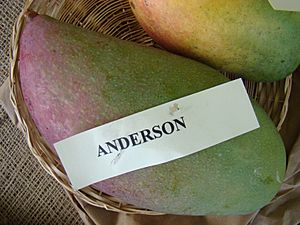Anderson (mango) facts for kids
Quick facts for kids Mangifera 'Anderson' |
|
|---|---|

The display of Anderson mango at the Redland Summer Fruit Festival, Fruit and Spice Park, Homestead, Florida.
|
|
| Genus | Mangifera |
| Species | Mangifera indica |
| Hybrid parentage | 'Sandersha' × 'Haden' |
| Cultivar | 'Anderson' |
| Origin | Miami, Florida, USA |
The Anderson' mango is a special type of mango that first grew in south Florida. It's known for its unique history and features.
How the 'Anderson' Mango Started
The first 'Anderson' mango tree began from a seed. This seed came from a 'Sandersha' mango in Jamaica. It was sent to Miami, Florida in 1926. The seed was planted on L. F. Anderson's property.
The tree started growing fruit in 1931. It was officially given the name 'Anderson' in 1948. Scientists later studied its family tree in 2005. They believe 'Anderson' is a mix of the 'Sandersha' and 'Haden' mango types.
The 'Anderson' mango did not become a popular fruit to sell in stores. This was because the fruit often split open while still on the tree. It also wasn't grown much in people's backyards. However, it was sometimes used to make chutneys, which are tasty fruit sauces.
Today, you can find 'Anderson' mango trees in special collections. These include the University of Florida's Tropical Research and Education Center. You can also see them at the Miami-Dade Fruit and Spice Park. Both places are in Homestead, Florida.
What the 'Anderson' Mango Looks Like
The 'Anderson' mango fruit is quite big. It usually weighs more than one pound (about half a kilogram). Its shape is long and thin, much like the 'Sandersha' mango. It also has a small bump called a lateral beak.
The skin of the fruit is thick. It changes color from green to yellow. Sometimes, it has a pretty crimson (deep red) blush. The inside of the fruit, called the flesh, is yellow. It has a slightly tart and mild flavor. It doesn't have any stringy fibers. Each seed is monoembryonic, meaning it usually grows only one plant.
In Florida, the 'Anderson' mango is ready to eat from July to August. The tree itself grows strongly. It has a large, somewhat open canopy, which is the leafy top part of the tree.

